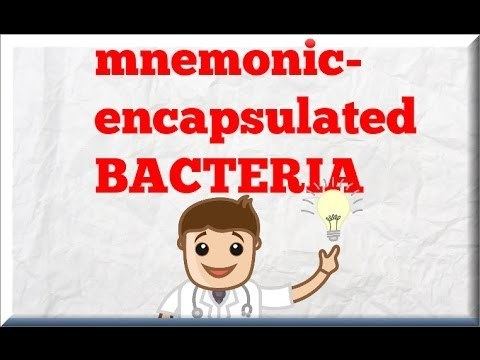 | ||
Representative species Salmonella enterica subsp en, Streptococcus pneumoniae, Haemophilus influenzae, Meningococcus, Klebsiella pneumoniae | ||
Polysaccharide encapsulated bacteria, frequently referred to simply as encapsulated bacteria and less precisely called encapsulated organisms, are a group of bacteria that have an outer covering, a bacterial capsule, made of polysaccharide.
Contents
Examples of encapsulated bacteria
A popular mnemonic to remember most of the encapsulated bacteria is the SHiNE SKiS bacteria (S. pneumo, Hib, N. meningitidis, E. Coli, Salmonella, Klebsiella, Group B Strep).
Role in disease
Many encapsulated bacteria are pathogens that lead to a significant amount of morbidity and mortality. The smooth surface and negative charge of the exterior capsule limits the ability of phagocytes to counteract the bacteria through cell-mediated immunity, and hence the humoral immune response of B cell antigens is important for the removal of encapsulated bacteria. Patients with B cell deficiencies are highly susceptible to encapsulated bacterial infections.
Asplenia
People that lack a spleen, functionally (as in sickle cell disease) or anatomically (due to a splenectomy or congenital absence, as in Ivemark Syndrome for example), have been shown to be more susceptible to these pathogens due to impaired opsonization of such organisms. Therefore, it is standard medical practice to recommend vaccination.
It is generally recommended that people with asplenia are vaccinated against Neisseria meningitidis, Haemophilus influenzae, and Streptococcus pneumoniae. These vaccines can be remembered with the mnemonic: SHiN. Alternatively they can be called the NHS bacteria, as in National Health Service in the UK.
Children
Young children do not have the ability to make antibodies to polysaccharides and are, therefore, more susceptible to encapsulated bacteria, the capsules of which contain polysaccharides. This is especially true for children between six months and one year old (who are typically not breastfed); in these children the maternal antibodies are depleted and endogenous synthesis is not perfected yet due to a poor T-cell independent response. Conjugate vaccines are used to produce an immune response in these cases.
Complement deficiency
Patients with complement deficiency are at risk of infections with encapsulated organisms. There are several types of complement deficiency, two of note are C3 and C5,6,7,8,9. A C3 deficiency allows for infection by encapsulated organisms. A C5,6,7,8,9 (the membrane attack complex) deficiency lead to unopposed Neisseria infections. Vaccination is essential in such patients.
